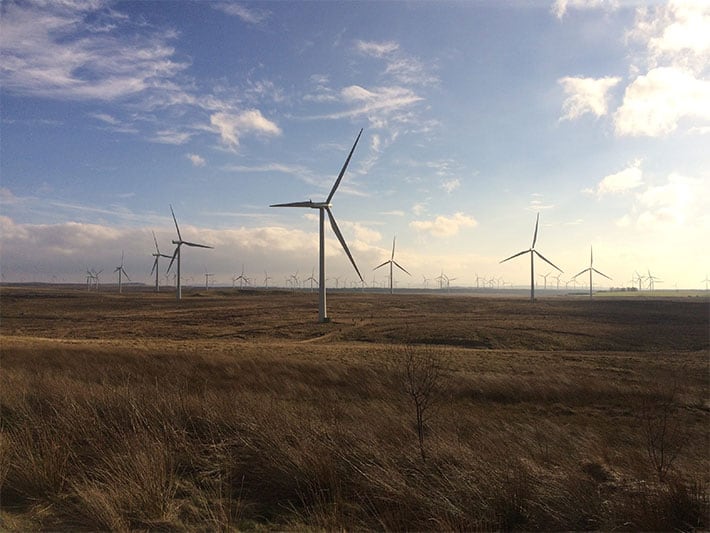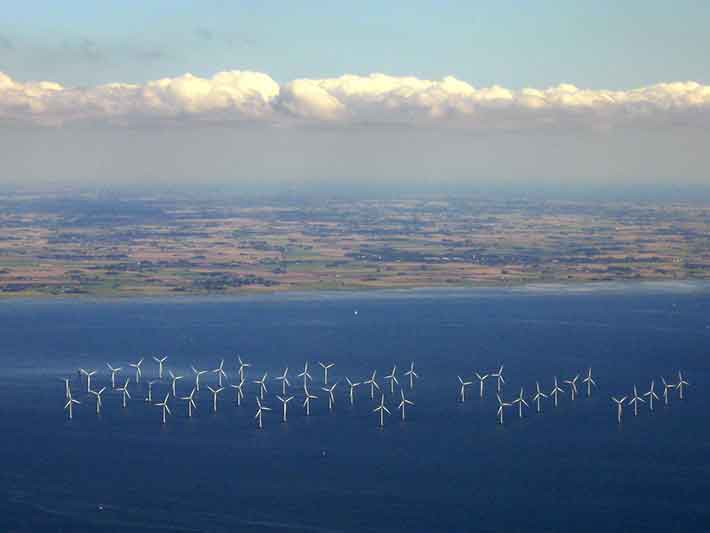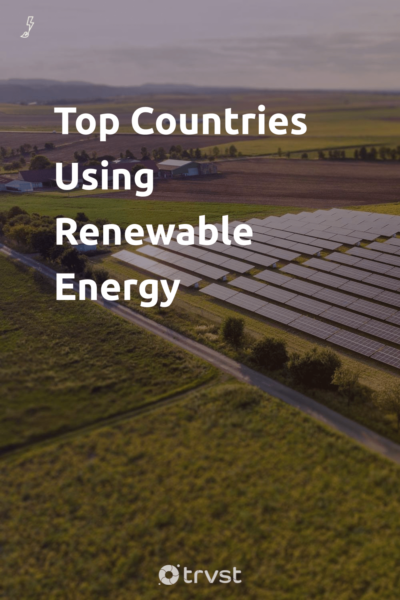Top Countries That Use Renewable Energy - Leading the Energy Transition
Renewable energy is crucial to tackling the climate emergency. To break the world's reliance on finite and polluting fossil fuels, nations around the globe must work towards a more sustainable future. The transition to a zero-carbon future will involve a multi-pronged approach. Impressively, top renewable energy countries are already seeing positive results.
Many countries have set ambitious targets for using renewable energy, and the market share of renewable energy continues to rise. Yet, the energy transition is slow globally. The most recent WEF Energy Transition Index notes that the energy transition has plateaued.
This shows us the scale of the problem and what more we can do to eliminate fossil fuels. According to the International Energy Agency (IEA), global energy demand will increase by another 25% by 20401. Renewable power generation is crucial for meeting this increase in total energy consumption.
Around half of the current global carbon emissions are from heat and electricity generation. A decarbonized grid is more than just desirable in the near future – it is essential to our planet's survival. Renewables provided more than 26% of global electricity generation in 2018, and that figure is steadily rising.
Accelerating Renewable Energy Uptake
But there is a long way to go if we are to avoid worsening climate catastrophes in the coming years. We have to do a lot more and do it faster. In the near future, we must completely overhaul our energy systems, invest, legislate, and innovate.
Related: 97 Inspirational Climate Change Quotes
We should make sure we eliminate our reliance on fossil fuels and take full advantage of renewable, green sources, to power, heat, and cool our homes and businesses, transport people and goods, and fuel industry in all its forms.
Whereas the climate crisis rightly dominates the narrative demanding the accelerated shift to renewables, numerous other benefits are within reach. From cleaning up polluted air to clean transport to huge job creation, the gains far outweigh the downsides measured in declining big oil balance sheets.
The power is abundant—solar energy, wind, geothermal, hydro, and more. We just have to harness that energy and put it to good use. At worst, the choice is between a liveable planet for future generations or not.
As in most issues, some countries and jurisdictions are further along the curve than others regarding renewable energy.
We must continue to hold nations accountable and ensure that we know where we are going wrong and where we are doing well when it comes to electricity consumption from polluting sources. Here are some of the countries leading the pack when it comes to this essential green energy transition.
Top Countries Using Renewable Energy
1. Iceland

Iceland is the world leader in renewable energies. The country's electricity production is 100% renewable and has been for some years. Now, around 85% of Iceland's primary energy supply comes from domestically produced renewable energy sources. This is the highest share of renewable energy in any total national energy budget.
Iceland heats around 85% of its homes with geothermal energy, hydropower, and wind power. It is also the world's largest green energy producer per capita and the largest electricity producer using renewable resources per capita.
2. Scotland

Scotland is also extremely close to meeting 100% of its electricity means through renewable power generation and is easily on track to do so this year. Onshore wind accounts for the largest percentage of renewable energy generation in Scotland, producing 70% of installed capacity. Scotland's other major renewable power sources are offshore wind, hydropower, and solar.
The focus is now on decarbonizing the heat and transport sectors. The government has declared a climate emergency and committed to reaching net-zero total emissions by 2045 – five years ahead of the rest of the UK and, crucially, without carbon offset purchases.
The Scottish Government has also adopted an ambitious new target to reduce emissions by 75% by 2030 – this is the toughest statutory target of any country in the world for this date.
3. Costa Rica

Costa Rica is another country that is close to getting 100% of its electricity from renewables. In 2019, 99.62% of the country's electricity came from renewable sources, largely hydropower, but also wind, geothermal energy, and a small proportion of solar.
With fewer than 5 million population, Costa Rica will find it easier to meet its energy targets than larger countries. The country aims to become 100% carbon neutral this year.
4. Norway

Currently, 97% of Norway's electricity comes from hydropower. The government is pushing its population towards a 100% renewable goal through wind farms, solar power, smart grids, and energy storage. An impressive number of startups and innovators in the country have helped to speed up the shift towards renewables.
While Norway is far from detached from the world's petrochemical reliance – we can link half of its total exports to oil and natural gas – Norway is leading the way with the transition to electric vehicles.
More than 200,000 pure electric plug-in vehicles are now on the road, and the country has ambitious goals to make all newly registered cars zero-emission within the next five years furthering its aims to reach carbon neutrality.
5. Sweden

More than half of Sweden's energy comes from renewable sources, and the country has set ambitious targets for the coming years. The country's electricity target is 100% renewable energy production by 2040. The power largely comes from hydropower, with bioenergy for heating.
Norway and Sweden have a joint electricity market, with a green energy certification scheme that applies to both countries. Sweden is one of the EU countries contributing most significantly to the decarbonization and renewable energy targets of the block.
Emerging Countries in Renewable Energy
Several markets for clean energy policy and practice are also emerging among developing nations. While everything is up in the air due to the current global health crisis, it is increasingly crucial that countries continue to make progress and accelerate toward a renewable energy future.
1. China
China is the world's leading country in terms of electrical production from renewable energy sources, with more than double the generation of the United States. By the end of 2019, the country had 800 GW of renewable power, mostly from hydroelectric and wind power.
China has installed more hydro, solar, and wind power generation than any other nation in the world. However, its huge energy requirements mean that, although market share is increasing, the share of renewables in the mix is still only around 30% of the country's total power generation coming from non-fossil fuel sources (including nuclear).
In the coming 2021-25 period, wind and photovoltaic power across China should fully achieve power grid parity. This is the tipping point at which their generation costs are the same or less as electricity from the power grid, which could lead to a rapid expansion of the sector.
However, China is also the world's largest carbon emitter as a function of large industrial manufacturing and the world's largest population.
2. India
The Indian government has set ambitious renewable energy targets, aiming for 175 GW by 2022. The power comes from solar, wind, and other sources. Large hydro accounts for over 22% of India's total installed electricity capacity, and this figure continues to rise as lower-cost renewables take up a larger share of the market.
3. Chile
Chile is another developing nation that green energy investors view as attractive. The government's targets include a goal of generating 20% of power for utilities from renewables by 2025, 60% by 2035, and 70% by 2050. Wind and solar continue to see investment and currently account for over 15% of installed capacity.
4. Brazil
Brazil has not been lauded for its environmental practices in recent years. Hydropower has long dominated the power supply, but other renewable generation has increased and continues to attract investment.
While deforestation and other environmental atrocities continue to hit the headlines, there is some hope that the country's increasing investment in renewables could speed the energy transition.
5. Kenya
Kenya is the largest producer of geothermal energy in Africa, accounting for almost 20% of the country's total energy generation. The country's total renewable energy capacity is 70%, mostly from hydropower. In 2019, the country opened the largest wind power plant in Africa and has an ambitious goal of reaching 100% green energy for its national power grid this year.
Despite progress in renewables uptake, energy efficiency, and energy access, the world is not on track to meet the targets of the Paris Agreement. In 2018, only 47 countries had targets for renewable heating and cooling. Renewable energy penetration in the transport sector remains low.
While a growing number of countries now have more than 20% variable renewables in their electricity mixes, and some countries have gone much further, there is still a long way to go in decarbonizing electrical grids. Furthermore, even bigger challenges are on the horizon as we tackle the global decarbonization of the industrial sector.
Conclusion
Every nation and individual must follow the lead of the top countries using renewable energy. We must come together to tackle the crises we all face. And even those nations leading the charge must do more and do it faster if we are to overcome the crises and transition to a sustainable future for all.

| 1 | IEA (2019), World Energy Outlook 2019, IEA, Paris https://www.iea.org/reports/world-energy-outlook-2019 |
